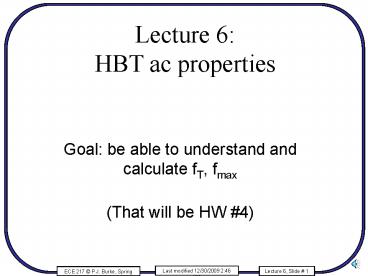Lecture 6: HBT ac properties PowerPoint PPT Presentation
1 / 34
Title: Lecture 6: HBT ac properties
1
Lecture 6 HBT ac properties
- Goal be able to understand and calculate fT,
fmax - (That will be HW 4)
2
Announcements
- HW 3 on website (there will be 6 total)
- IB,p is reverse injection current base-em
- IB,scr is current due to bulk recombination in
base - Presentations weeks 8,9,10
- If you are in week 8, two week delay on all HW
allowed - If you are in week 9, one week delay on all HW
allowed.
3
Possible presentation topics
- Resonant tunnel diodes (RTD)
- GaN
- SiGe
- Quantum dots
- Landauer-Buttiker formalism for conductance and
quantum point contact - Fabrication techniques
- Optical properties of heterostructures
- Noise models
- S-parameter measurement techniques
- Circuit designs based on our developed device
models (tools available such as SPICE, etc.) - Growth techniques MBE, MOCVD, LPE
- High power applications and effects
- High speed digital applications
- Gunn diode
- IMPATT diode, P-I-N diode
- Carbon nanotubes
- Polymer transistors
- If you are involved with related research, I
encourage presentation of your data.
4
HW 3 help
5
Objectives
- Understand y, h parameters (HW4.1)
- Understand how to calculate intrinsic y
parameters from geometry and doping profile
(HW4.2) - Understand how to calculate fT, fmax for simple
circuits (HW4.3) - Understand design tradeoffs (HW4, prs. 4-7)
6
Bipolar advantages
- Speed set by base thickness, which is easy to
control during material growth(Dont need
deep-submicron lithography) - Large area contributes to current, good for
POWER - Low 1/f noise good for OSCILLATORS
7
Bipolar dis-advantages
- Need base current at dc
- No easy complementary digital logic
- Not so good at low-noise at high frequencies
(HEMTs win here) due to generation-recombination
noise
8
Normal active schematic
p type base
n type collector
n type emitter
electrons
Ic
electrons
Ie
recombine
a few holes
holes
(review all current components)
Ib
9
Normal active bias
- E-B forward bias(VbgtVe)
- C-B reverse bias(VcgtVb)
- Ice 100 IbebIbe
Ic
Ib
Ie
Like a diode.
10
Equivalent circuit 1
Ic
Ib
Ie
11
Equivalent circuit 2
Ic
Ib
Ie
12
Equivalent circuit 3
Ib
Ic
Ie
13
Equivalent circuit 4
Ib
Ic
Ie
14
npn spelled backwards?
- npn
15
Equivalent circuit 1
Ic
Ib
Ie
16
Ebers-Moll model
Ic
Note Npn spelled backwards is npN
Ib
Ie
Not just limited to forward-active regime. Not in
Liu, applies to all bias voltages. (Good for all
sorts of circuits.)
17
Ebers-Moll model AC
Ic
Cbc
Ib
Ceb
Ie
18
E-M model AC with parasitics
Ic
j is for junction (discuss) Diffusion capacitance
not shown.
Cjc
Ib
Cej
Note at frequencies near fT, things are not
quite this simple.
Ie
19
Global dc properties
Note Early effect.
(Discuss bias scheme.)
20
Global dc properties
Note Early effect.
It is assumed you know this, so it is rare to see
on data sheets!
http//www.toshiba.com/taec/components/Datasheet/2
SA1244DS.pdf
21
S-parameters
This is what you see on data sheets. Related to
input impedance, output impedance, and gain vs.
frequency. gt Need to discuss ac performance.
22
ac properties notation
Ic
Ib
Ie
We will use equivalent circuit 1 (implicitly).
23
ac properties
common-emitter configuration
VCC
Rc
output
Note three terminal device has three-terminal
equivalent ac circuit.
24
dc analysis
common-emitter configuration
VCC
Rc
IC
IB
0 for now
IE
25
ac analysis
VCC
Rc
output
We will prove
Transconductance
Note three terminal device has three-terminal
equivalent ac circuit.
26
Transconductance
VCC
Rc
But
Typical number is 40 mA/V.
gm
So
27
Input impedance
VCC
Rc
But
So
So
What is typical input impedance?
28
Gain
VCC
Rc
But
So
So
What is typical gain?
29
Summary
VCC
Rc
input imp.
transcond.
In matrix form
Admittance (Y) matrix
30
AC equivalent circuit
If we are only interested in ac components, life
can be simplified
VCC
Rc
Hybrid p model
31
T-model
If we are only interested in ac components, life
can be simplified
VCC
Rc
T model
32
Rules for ac analysis
- From complete circuit, calculate dc currents and
voltages - For ac analysis only
- dc voltage source -gt short circuit
- dc current source -gt open circuit
- Replace transistor with p or T-model
- Now solve (simplified) ac circuit
33
Next lecture
- Generalized y-parameters
- not just common emitters
- Capacitances
- y-parameters from doping profile
- Definition of fT
34
Time permitting
- Early effect in p model
- S-parameters

